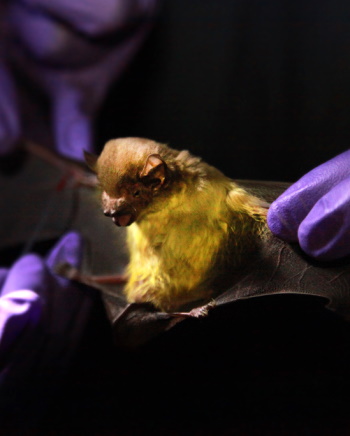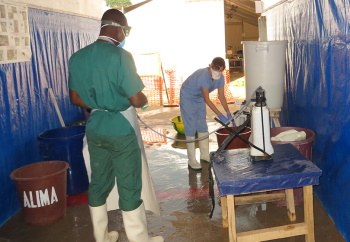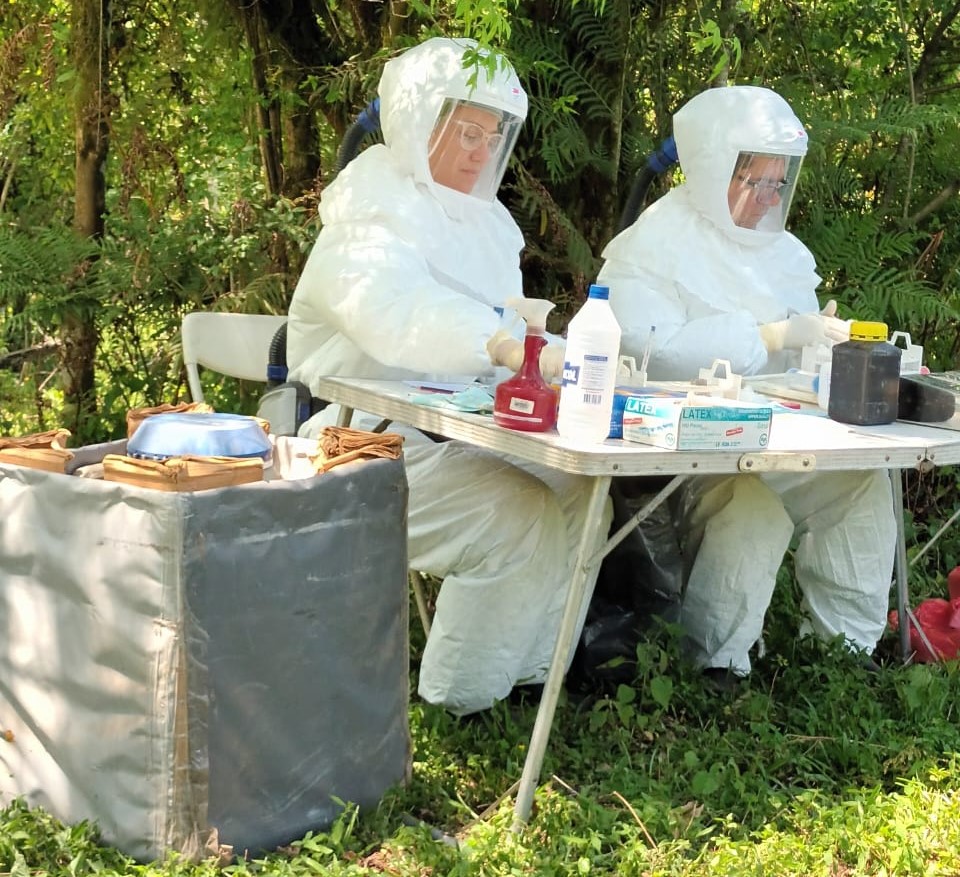
Emerging Infectious Diseases and Pathogens
Emerging infectious diseases are those infectious diseases that have been recently discovered and are increasing rapidly in incidence or geographic range. NIAID, in collaboration with the Department of Homeland Security and the Centers for Disease Control and Prevention (CDC), classifies these pathogens as A, B, or C, depending on the disease severity, transmission rate to people, and the need for public health preparedness. Several Class A pathogens, those that are of highest risk to national security and public health, are being studied as part of the CREID Network, including bunyaviruses, coronaviruses, flaviviruses, and filoviruses. Most emerging infectious diseases are zoonoses, meaning they are infectious diseases that have passed from animals to humans. They may involve bacterial, viral, or parasitic infectious agents. Many of the viruses are arboviruses, meaning they are transmitted by arthropods, most commonly mosquitos and ticks, such as West Nile virus, yellow fever virus, Zika virus, Crimean-Congo hemorrhagic fever virus, and Chikungunya virus. Others, such as SARS-CoV-2 do not require an arthropod for transmission. See the NIAID website for more information.
Filoviruses
Filoviridae is a virus family that can infect humans and non-human primates and cause severe hemorrhagic fever. Filoviruses originate in animals such as bats and primates and are passed to humans through direct contact with an infected animal. Filovirus outbreaks can be explosive due to the virus being easily transmissible from person-to-person. Rapid outbreak response is necessary to bring these outbreaks under control and prevent further spread. Filoviruses are endemic in regions of Central, Eastern, and Western Africa. They are among some of the deadliest human pathogens that have been identified. Mortality rates have ranged from 24% to 90% depending on the strain of the virus and available medical treatment, with an average overall mortality rate of 50%. See the NIAID website for more information.

Ebola
Ebola virus disease is a viral hemorrhagic fever caused by infection with a virus species in the Ebolaviruses genus. It often has high mortality rates and affects humans and primates. Ebola virus disease was first described in 1976 in the Democratic Republic of the Congo. The virus spreads to people initially through direct contact with the blood, body fluids, or tissues of an infected animal. It continues to spread person-to-person through close contact with an infected person, or the body fluids of a person who is sick with or has died from Ebola virus disease. See the CDC website or the WHO website for more information.
Marburg
Marburg virus was first discovered in 1967 when laboratory workers who were working with African monkeys in Marburg, Germany became ill. There have since been outbreaks in Angola, Democratic Republic of Congo, Kenya, South Africa, and Uganda, as well as Germany and Serbia. Symptoms of Marburg virus disease are similar to other infectious diseases at onset, including fever, chills, and headache, and can be mistaken for malaria or typhoid fever but disease often progresses to a more severe form that has similar characteristics to Ebola virus disease, and can have high case fatality rates. The one known natural host of the Marburg virus is the African fruit bat, which as the reservoir host does not show signs of disease. See the CDC website for more information.
Flaviviruses
Flaviviridae is a family of small, single-stranded, enveloped ribonucleic acid (RNA) viruses. Some flaviviruses can be transmitted to humans or animals by infected arthropods such as ticks and mosquitos and cause disease (arboviruses). Some of the mosquito-transmitted flaviviruses can cause diseases such as yellow fever, dengue fever, Japanese encephalitis, West Nile fever, and Zika fever. See the CDC website for more information.

Yellow Fever
Yellow fever virus is a flavivirus that is spread to people through bites by infected mosquitos. Infection with yellow fever virus can cause symptoms ranging from a fever with aches and pains, to severe liver disease, bleeding abnormalities, yellowing skin, organ failure, and death. Yellow fever is most commonly found in tropical and subtropical areas of Africa and South America. See the CDC website for more information.
Dengue
Dengue virus is spread to humans through the bite of an infected mosquito and is caused by one of four related virus serotypes: dengue virus 1, 2, 3, and 4. Some people who are infected with dengue virus experience no symptoms or very mild symptoms. Others experience high fever, aches and pains, and rash. More severe forms of dengue fever, called dengue hemorrhagic fever and dengue shock syndrome, can cause severe bleeding, organ failure, and death. Dengue is carried by Aedes species mosquitos and is found in tropical and subtropical areas of the Americas, Africa, the Middle East, Asia, and the Pacific Islands. See the NIAID website or the CDC website for more information.
Japanese Encephalitis
Japanese encephalitis virus is a flavivirus and is transmitted to humans, primarily in rural areas of Asia and the Western Pacific through the Culex species of mosquitos. Japanese encephalitis is the leading cause of vaccine-preventable encephalitis in those regions. While most people have mild symptoms, a small percentage of people experience severe disease, which includes brain inflammation (encephalitis), with an estimated 25% fatality rate for severe cases. See the CDC website for more information.
Zika
Zika virus is a flavivirus that is primarily spread to humans through the bite of infected mosquitos. Zika virus can be passed from an infected pregnant woman to her baby and cause serious birth defects. Furthermore, it can be transmitted during sexual intercourse or blood transfusion. Most people who become infected with Zika virus do not develop symptoms. The 20 percent of infected people who do become sick usually experience mild symptoms that include fever, rash, joint pain, and red eyes. A small percentage of people may develop Guillain-Barré syndrome, a rare neurological disorder with a spectrum of severity that often resolves over several months. Zika continues to be a concern around the world with a total of 86 countries and territories reporting evidence of mosquito transmitted Zika virus since its discovery. Because it is carried by Aedes mosquitos, it is found in similar areas as dengue. See the NIAID website for more information.
West Nile
West Nile virus was first discovered in Uganda in 1937 and is common in Africa, Europe, the Middle East, North America, and West Asia. West Nile virus is the primary cause of mosquito-borne disease in the U.S., with the first outbreak in the U.S. in 1999; it is now found in 25 states. Human infection is most often caused by the bite of infected Culex mosquitos; mosquitos become infected when they bite infected birds, which are the natural reservoir of West Nile virus. Transmission of West Nile virus has also been observed in organ transplants, blood transfusions, and breast milk. While 80% of people do not develop any symptoms, approximately 20% of people who are infected with West Nile virus develop a fever, while about 1 in 150 people develop serious and sometimes fatal illness, including inflammation of the brain and spinal cord. See the NIAID website or the WHO website for more information.
Bunyavirales
Bunyavirales is an order of more than 300 viruses and includes the viral families Arenaviridae, Hantaviridae, Nairoviridae, and Phenuiviridae among others. These viruses have genomes that are multi-segmented, single-stranded, enveloped ribonucleic acid (RNA). Example viruses in this order include Crimean-Congo hemorrhagic fever virus, Rift Valley fever virus, Lassa virus, and Sin Nombre virus, the latter two transmitted by rodents, causing mild to severe disease in humans. Some of these viruses must be handled in a Biosafety Level 3 or Biosafety Level 4 laboratory given the potential severity of human disease. See the CDC website for more information.

Crimean-Congo Hemorrhagic Fever
Crimean-Congo hemorrhagic fever virus belongs to the Nairoviridae virus family and is a tick-borne virus that can be found in Eastern Europe, Southern Europe, the Mediterranean, China, Central Asia, the Indian subcontinent, Africa, and the Middle East. Crimean-Congo hemorrhagic fever symptoms include headache, fever, back pain, joint pain, stomach pain, and vomiting and in outbreaks, mortality rates can range from 9% to 50%. See the CDC website for more information.
Lassa
Lassa virus is part of the Arenaviridae virus family (recently reclassified as part of the Bunyavirales order) and is found in West Africa, including Sierra Leone, Liberia, Guinea, and Nigeria. Lassa virus is transmitted to humans via the urine of the multimammate rat. People are exposed to Lassa virus through ingestion or inhalation of the virus, with food contaminated with rat urine as one route of transmission. Mild symptoms of Lassa fever include fever, weakness, and headache, with serious symptoms including bleeding, respiratory distress, vomiting, and pain in the chest, back, and abdomen. Lassa fever leads to approximately 5,000 deaths annually. See the CDC website for more information.
Rift Valley Fever
Rift Valley fever is part of the Phenuiviridae virus family and is often seen in domesticated animals such as cattle and sheep and is endemic to much of Sub-Saharan Africa. Rift Valley fever virus can be transmitted to humans through contact with blood, bodily fluids, or tissue of infected animals, as well as through mosquitos. It was first discovered in 1930 in an outbreak in sheep in East Africa. Symptoms of Rift Valley fever can range from mild to severe, with approximately 8-10% of people developing severe symptoms including eye disease, excessive bleeding, and swelling of the brain (encephalitis). See the CDC website for more information.
Additional Pathogens of Interest
The CREID Network is set up to study a variety of pathogens and virus families. Additional pathogens currently under study by CREID research centers include Chikungunya, an arbovirus part of the Togaviridae virus family, and Nipah virus, part of the Paramyxoviridae virus family. The CREID Network is also intended to be adaptable to quickly address and research newly emergent diseases that are currently unknown, referred to as Disease X.

Chikungunya
Chikungunya virus is part of the Togaviridae virus family and is spread through the bite of mosquitos, often the same mosquitos that transmit dengue virus, Zika virus, and several other mosquito-borne viruses. In rare cases, Chikungunya can be transmitted from mother to child at birth and in very rare cases, the virus can be spread through blood transfusion. Common symptoms include fever and joint pain, with some people, including infants and people older than 60 at risk of severe disease. Chikungunya is found worldwide in the Americas, Africa, Asia, Europe, and the islands of the Indian and Pacific Oceans. See the CDC website for more information.
Nipah
Nipah virus is part of the Paramyxoviridae virus family and was first discovered in 1999 in Malaysia and Singapore among pig farmers. Flying foxes (Pteropus bats) are the natural reservoir of the virus and are found in China, Southeast Asia, India, Australia, and Madagascar. Transmission to humans can occur through direct contact with infected bats, pigs, or from other people infected with Nipah virus, with one route of transmission occurring via bat-urine contaminated products (such as date palm sap). Symptoms include fever, headache, drowsiness, and mental confusion and can lead to brain inflammation (encephalitis). About 40% of people with serious illness die of the disease. See the CDC website or the WHO website for more information.
Disease X
Disease X represents a pathogen that could cause an international epidemic or pandemic but is currently unknown to cause disease in humans. Disease X research is often focused on whole families or classes of pathogens (ex. viruses) to more broadly understand common qualities and characteristics of these pathogens. This broad knowledge aids in more rapid outbreak response activities to address new or novel pathogens that have yet to emerge. See the WHO website for more information.

